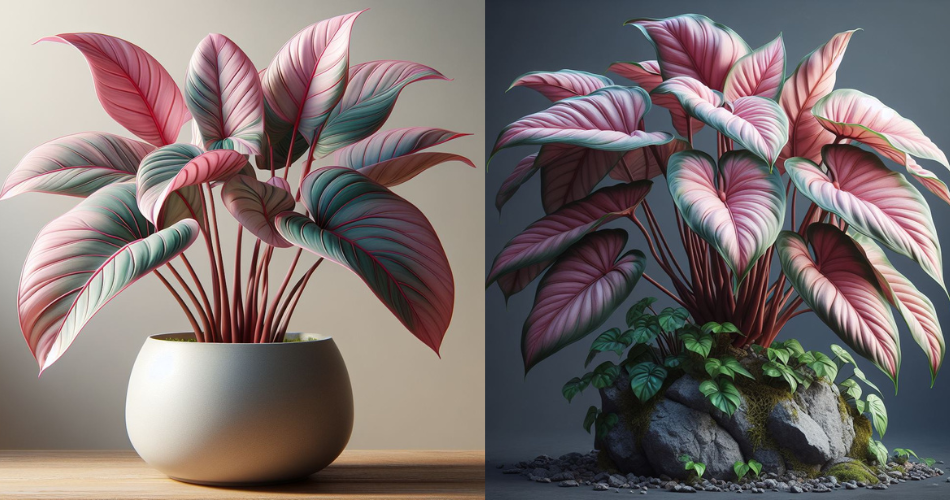
Welcome to the world of Philodendron Mamei, a stunning tropical plant known for its unique and captivating features. Whether you are a seasoned plant enthusiast or a beginner looking to explore the wonders of indoor gardening, this article will provide you with all the essential information you need to successfully grow and care for Philodendron Mamei. From understanding its growth requirements and selecting the perfect location to proper soil and potting techniques, watering and humidity needs, fertilizing and pruning tips, pest identification and treatment, as well as propagation and repotting techniques – we’ve got you covered. Get ready to embark on a journey of cultivating and nurturing this exquisite plant in your own space, as we dive into the fascinating world of Philodendron Mamei.
1.1 What is Philodendron Mamei?
Philodendron Mamei, also known as Mamei Philodendron, is a stunning tropical plant that belongs to the Araceae family. With its vibrant green leaves and unique texture, it is a popular choice for plant enthusiasts looking to add a touch of exotic beauty to their indoor or outdoor spaces.
Is Philodendron mamei indoor or outdoor plant?
Philodendron mamei is primarily grown as an indoor plant. Native to the rainforests of Colombia, it thrives in warm and humid conditions. Therefore, it is well-suited for indoor environments where temperature and humidity can be controlled.
While it can be grown outdoors in tropical or subtropical regions with similar conditions, many plant enthusiasts choose to cultivate Philodendron mamei as a beautiful and exotic addition to their indoor gardens. When grown indoors, it’s important to provide the plant with proper support for its climbing tendencies and to mimic its natural habitat as closely as possible for optimal growth.
1.2 Overview of Philodendron Mamei’s Unique Features
What sets Philodendron Mamei apart from other houseplants is its distinctively velvety leaves. Imagine reaching out to touch a leaf and feeling a soft, almost plush-like texture. It’s like having a pet plant that you can’t resist stroking. Plus, the leaves have an intriguing heart shape, making them even more adorably charming. These unique features make Philodendron Mamei a standout addition to any plant collection.
How do you identify a Philodendron mamei?
Identifying Philodendron mamei involves considering its distinct characteristics. Here are key features to help you recognize this plant:
- Leaf Structure: Philodendron mamei has large, heart-shaped leaves that are deeply lobed with pronounced cutouts along the edges. The leaves may also exhibit a velvety texture.
- Leaf Color: The leaves of Philodendron mamei typically have a vibrant green color. The underside of the leaves may have a contrasting reddish-purple hue.
- Vein Patterns: Look for prominent veins on the leaves. Philodendron mamei often displays contrasting and well-defined vein patterns, adding to its unique appearance.
- Growth Habit: As a climbing plant, Philodendron mamei tends to grow vertically, and it benefits from support structures like stakes or trellises.
- Size: Mature Philodendron mamei plants can reach a significant size, with large leaves and a robust overall appearance.
- Habitat: Consider the plant’s natural habitat. Philodendron mamei is native to the rainforests of Colombia, so it thrives in warm and humid conditions.
Observing these features can help you confidently identify Philodendron mamei and distinguish it from other Philodendron species.
2. Understanding the Growth Requirements of Philodendron Mamei
2.1 Temperature and Climate Considerations
When it comes to keeping your Philodendron Mamei happy, temperature and climate play a crucial role. Ideally, this tropical beauty thrives in temperatures ranging from 65°F to 80°F (18°C to 27°C). It appreciates a warm and humid environment, but can also tolerate slightly lower temperatures. Just be sure to protect it from frost and extreme temperature fluctuations.
2.2 Light and Sunlight Requirements
Philodendron Mamei enjoys bright, indirect light. It prefers a spot near a window where it can receive filtered sunlight or dappled shade throughout the day. However, direct sunlight can scorch its delicate leaves, so it’s best to avoid exposing it to intense rays. If you notice your plant getting leggy or its leaves losing their vibrant green color, it might be an indication that it needs more light.
2.3 Ideal Soil Composition
When it comes to soil, Philodendron Mamei appreciates a well-draining and fertile mix. A combination of peat moss, perlite, and a good-quality potting soil works wonders for its growth. Avoid using heavy, compacted soils that can suffocate the roots and hinder proper drainage. Remember, happy roots make for a happy Philodendron Mamei!
3. Choosing the Right Location for Philodendron Mamei
3.1 Indoor vs. Outdoor Placement
Deciding whether to keep your Philodendron Mamei indoors or outdoors depends on your climate and personal preference. It can thrive as an indoor plant, brightening up your living space with its lush foliage. However, it can also flourish outdoors in suitable climates, adding a touch of tropical paradise to your garden or patio.
3.2 Factors to Consider When Selecting an Indoor Spot
When selecting an indoor spot for your Philodendron Mamei, aim for a location that receives bright, indirect light. It can be a corner near a window or a spot close to a curtain. Consider the temperature and humidity of the room as well, as this plant appreciates warm and humid conditions. Additionally, ensure that there is enough space for it to grow, allowing its beautiful leaves to unfurl without being cramped.
4. Proper Soil and Potting for Philodendron Mamei
4.1 Soil Types Suitable for Philodendron Mamei
For optimal growth, ensure your Philodendron Mamei is planted in well-draining soil. A mixture of peat moss, perlite, and high-quality potting soil provides the ideal environment for its roots to thrive. This combination facilitates proper water retention and prevents soggy soil, which can lead to root rot.
4.2 Potting Techniques and Container Selection
When it comes to potting, choose a container with drainage holes to prevent water from pooling at the bottom. This helps in maintaining proper soil moisture levels and prevents root-related problems. Ensure the pot is the right size for your plant, allowing room for growth but not excessively large, as a smaller pot can help promote healthy root development. When repotting, gently loosen the roots and place the plant in the new container with fresh soil, giving it a fresh start to continue its growth journey.
With these tips and a little love, your Philodendron Mamei will reward you with its velvety leaves and charming presence in your home or garden. So go ahead, embrace the uniqueness of this tropical beauty and watch it flourish!
5. Watering and Humidity Needs of Philodendron Mamei
5.1 Establishing an Effective Watering Routine
Watering your Philodendron Mamei is like finding the perfect balance in life – not too much, not too little. These plants prefer their soil to be consistently moist, but not waterlogged. So, if you’re thinking of drowning them with love, hold up! Allow the top inch of soil to dry out before watering again. It’s a bit like waiting for your favorite Netflix show to release a new season – patience is key.
5.2 Creating and Maintaining Optimal Humidity Levels
Humidity-loving Philodendron Mamei enjoys a tropical spa-like environment. If you want to keep this plant happy, consider investing in a humidifier or placing a tray of water near it. You could even pamper your plant with a regular misting session to give it that fresh-from-the-shower glow. Just make sure you don’t overdo it, or your Philodendron might start thinking it’s auditioning for a role in a rainforest-themed reality show.
6. Fertilizing and Pruning Tips for Philodendron Mamei
6.1 Choosing the Right Fertilizer
When it comes to fertilizing your Philodendron Mamei, think of it as treating your plant to a nutrient-packed smoothie. Opt for a balanced, water-soluble fertilizer and follow the instructions on the label. Remember, too much of a good thing can be harmful, so go easy on the fertilization. After all, even plants need to watch their figure!
6.2 Pruning Techniques for Maintaining Shape and Health
Pruning your Philodendron Mamei is like giving it a stylish haircut. You can trim away any leggy or unruly growth to help maintain its shape and promote healthier foliage. Just remember to use clean and sharp tools, like a skilled hairdresser, to avoid any messy cuts. And don’t forget to step back and admire your handiwork, because a well-pruned Philodendron is a thing of beauty.
7. Identifying and Treating Common Pests and Diseases of Philodendron Mamei
7.1 Common Pests Affecting Philodendron Mamei
Let’s face it, pests are the uninvited guests in the plant world. Spider mites and mealybugs are the party crashers that can cause damage to your Philodendron Mamei. Keep an eye out for their presence and act swiftly with insecticidal soap or neem oil if they decide to make themselves at home. Remember, your plant deserves to party pest-free!
7.2 Recognizing and Treating Common Diseases
Nobody likes falling ill, including our dear Philodendron Mamei. Powdery mildew and root rot are common ailments that can affect this plant. To keep your Philodendron in tip-top shape, avoid overwatering, provide good air circulation, and keep its foliage dry. If it does happen to catch a cold, treat it with a fungicide or trim away affected parts. A little TLC goes a long way in keeping diseases at bay.
8. Propagation and Repotting Techniques for Philodendron Mamei
8.1 Propagation Methods for Philodendron Mamei
Looking to expand your Philodendron family? Well, lucky for you, Philodendron Mamei can be propagated through stem cuttings. Simply take a 4-6 inch cutting with a node, place it in a damp rooting medium, and watch it sprout roots like it’s auditioning for a gardening show. Before you know it, you’ll have a newborn Philodendron ready to be potted!
8.2 Repotting Guidelines for Healthy Growth
Like a teenager outgrowing their clothes, Philodendron Mamei might need a new pot as it grows. Repotting every 2-3 years can give your plant the space it craves. Just remember to choose a pot that’s slightly larger than the current one, use well-draining soil, and handle your plant with care. Think of it as giving your Philodendron a new home where it can spread its roots and flourish.
By following the guidelines and tips outlined in this article, you can confidently grow and care for your Philodendron Mamei. Remember to provide it with the right conditions, including proper lighting, soil, and humidity levels. Regular watering, fertilizing, and pruning will help ensure its health and vitality. Stay vigilant against common pests and diseases, and take prompt action if any issues arise. With patience and dedication, you can enjoy the beauty and elegance of a thriving Philodendron Mamei in your home or garden. Happy growing!
Is Philodendron mamei a crawler or climber?
Philodendron mamei is a climbing plant. It typically exhibits climbing or vining behavior, and it can be encouraged to climb by providing it with a suitable support structure such as a trellis or stake. Proper support will help the Philodendron mamei display its natural climbing tendencies and create an attractive and well-maintained appearance.
FAQ
1. Can Philodendron Mamei be grown outdoors?
Yes, Philodendron Mamei can be grown outdoors in suitable climates. It thrives in warm and humid conditions, so if you live in a region with a tropical or subtropical climate, you can consider growing it in your garden or as part of your outdoor landscaping.
2. How often should I water my Philodendron Mamei?
The watering frequency for Philodendron Mamei depends on various factors such as the temperature, humidity levels, and the type of soil it is planted in. As a general guideline, it is recommended to water your Philodendron Mamei when the top inch of soil feels dry. However, it’s essential to avoid overwatering and ensure proper drainage to prevent root rot.
3. How do I propagate Philodendron Mamei?
Philodendron Mamei can be propagated through stem cuttings. Select a healthy stem, preferably with a few leaves, and make a clean cut just below a node. Place the cutting in a jar of water or a well-draining potting mix and keep it in a warm, humid environment. Within a few weeks, roots will begin to develop, and you can then transfer the cutting into its own pot.
4. What are some common pests that affect Philodendron Mamei?
Some common pests that can affect Philodendron Mamei include aphids, mealybugs, spider mites, and scale insects. Regularly inspect your plant for signs of infestation, such as yellowing leaves, sticky residue, or webbing. If you notice any pests, it’s important to take immediate action to prevent them from spreading and damaging your plant.





